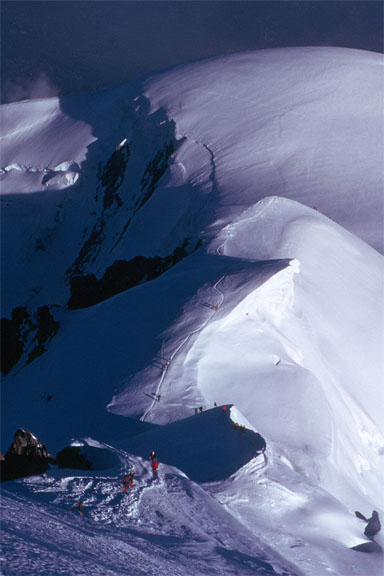The new day’s weather promised to be pristine as we dropped leisurely to the broad, 13,900-foot Col du Dome
and engaged the famous Arête des Bosses. This ridge is easy by alpine standards,
but its beauty can still make a mortal heart turn triple flips.
There are good reasons why so many people climb in the Alps.
We ascended the narrow arête in a tinkling halo of airborne ice crystals,
and stepped into the morning sun on Mont Blanc’s summit.
– Gerry Roach - from Ride the Breath |
15,771-foot Mont Blanc in the French Alps |
Mont Blanc is the highest peak in France, the Alps, and Western Europe. A sub summit of Mont Blanc is the highest point in Italy. |
 |
Welcome to the French Alps
The dominating 12,000-foot rise of Mont Blanc as seen from Le Brevant
Summits left to right: Mont Blanc du Tacul, Mont Maudit, Mont Blanc, Dome du Gouter.
This is the north or French side of the mountain. Chamonix, the birthplace of alpinisim,
is in the valley at the bottom of the photo. |
 |
Approaching the summit of Mont Blanc
Looking down the famous Arête des Bosses across the 14,121-foot Dome du Gouter |
| Photos by Gerry Roach |
It is no accident that Chamonix evolved as the world center for alpinism, since Mont Blanc soaring over two miles above town
has always been hard to ignore. However, in medieval times superstitious people saw the mountain as the home of serpents,
and avoided its dangerous slopes. In 1760, eyes turned upward with new intent when professor Horace Saussure offered a cash prize
for the first person to step onto the summit, but the motivation was not just sport. People suspected, but could not prove,
that Mont Blanc was the highest peak in Western Europe, and the way to prove it was to take barometric readings from the summit.
A second motivation was glory—not as a climber, but as a vanguard scientist. For the next 23 years, Mont Blanc defeated all aspirants. |
| In 1783, Michel Paccard, a doctor in Chamonix, wrote to his colleague Saussure in Geneva, and referred to Mont Blanc as
“our” mountain. After decades of failed attempts, there was now a third motivation for the ascent—pride.
With outsiders probing the slopes looking for a route, the locals wanted the prize for themselves. Over the next three years
Paccard observed the mountain carefully, devised a different route, and began to call Mont Blanc “his” mountain.
But Paccard still had to climb it. |
| During his secret preparations, Paccard recruited an iron-willed crystal hunter named Jaques Balmat who had been on the mountain
several times already. Just before starting, Paccard told a friend in town where and when to look for them on the heights.
Eschewing a large, over-equipped team, Paccard and Balmat set an enduring alpine standard. Planning a quick ascent,
the two men left Chamonix with light packs, a long pole, and of course, the barometer. Climbing into the evening by moonlight,
they stopped for their first bivouac at 7,500 feet. Continuing at 4:15 the next morning, they struggled upward all day,
until Balmat refused to continue when Paccard moved onto the virgin snows of his long-planned alternate route.
During the ensuing harried discussions, Paccard used his barometer to estimate their altitude at 12,600 feet.
Buoyed by this number, the pair continued, and observers in town watched them reach the summit together at
6:23 PM on August 8th, 1786, a moment that is embossed as the beginning of modern alpinism. |
| – Gerry Roach - from Ride The Breath |


